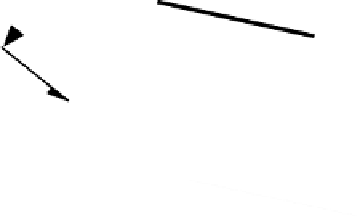Geoscience Reference
In-Depth Information
(b)
Surface stress
-
s
(a)
s
n
s
a
t
-
s
(c)
s
n
-
t
Traction and traction
components
(a) Non-Hydrostatic stress tensor
-
t
z
s
n
Surface stress
components
x
Fig. 3.59
(a) As forces,
tractions
(forces acting over a surface) can be
resolved into a normal (
); (b) Surface
stress, a pair of equal in magnitude and opposed in direction trac-
tions at equilibrium; (c) Surface stress components resolved for (b).
n
) and a shear component (
(b) Hydrostatic stress tensor
z
x
o
Fig. 3.58
The stress tensor defines an ellipse in 2D and an ellipsoid in
3D. In the particular case of hydrostatic stress, it defines a circle in
2D and a sphere in 3D.
y
o
of the stress tensor is still very regular but acquires the
nature of an ellipse in 2D or an ellipsoid in 3D (Fig. 3.58a).
As in fluid forces, solid tractions can be resolved into
stress components, one normal to the surface which is
called
normal traction
n
and a component parallel to the
surface named
shear traction
,
(Fig. 3.59a). It is usual to
name these traction components
normal stress
and
shear
stress
respectively. In the hydrostatic state of stress all trac-
tions are normal components and are applied at 90
to
all possible surfaces; there are no shear stresses in any
direction. In order to have shear stress components, the
tractions for different directions have to be unequal and
they have to act over a surface orientated at a certain angle
different to 90
.
In order to illustrate this point and to visualize how
stresses are distributed in a rock, imagine a mass of sta-
tionary rock in which many different surfaces exist
(Fig. 3.60). These surfaces are abundant in natural crustal
rock and may comprise joints, faults, stratification planes,
crystal lattices, and so on and even so we can also imagine
other virtual surfaces which, even when not present at the
moment, may potentially have been developed or can be
developed at some time in the future. Forces acting at a
Fig. 3.60
Forces acting over a small volume of rock in an outcrop.
Many surfaces with different orientations can be defined. We can
extract an imaginary cube and define the tractions acting on the
surfaces.
point, actually over a infinitesimal volume of rock (as points
are dimensionless and lack surfaces) will give the full stress
tensor, with tractions or vectors acting over all the differ-
ent surfaces with all possible orientations. From the mass
of rock we can extract a tiny imaginary cube over which



















Search WWH ::

Custom Search